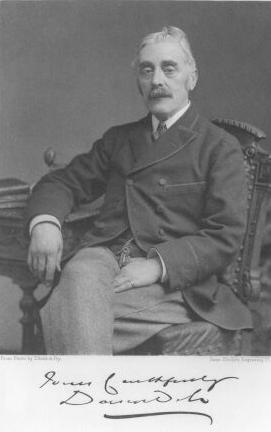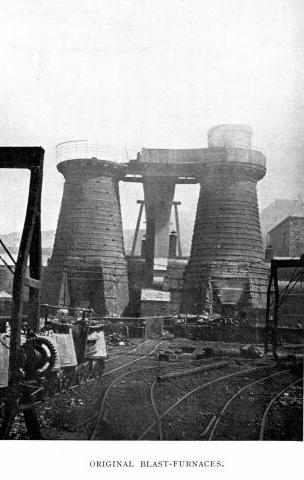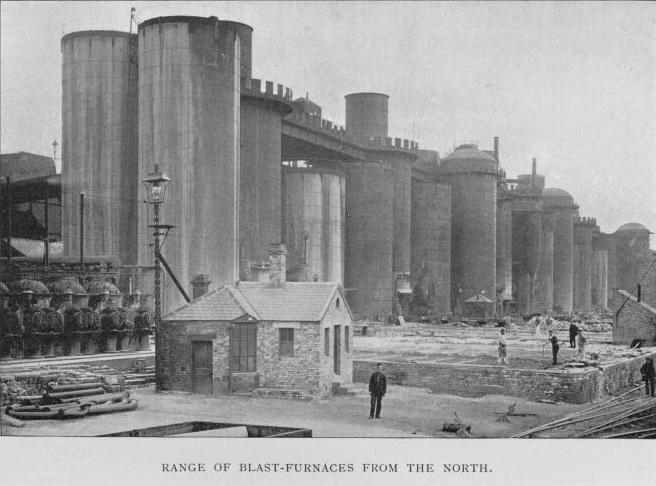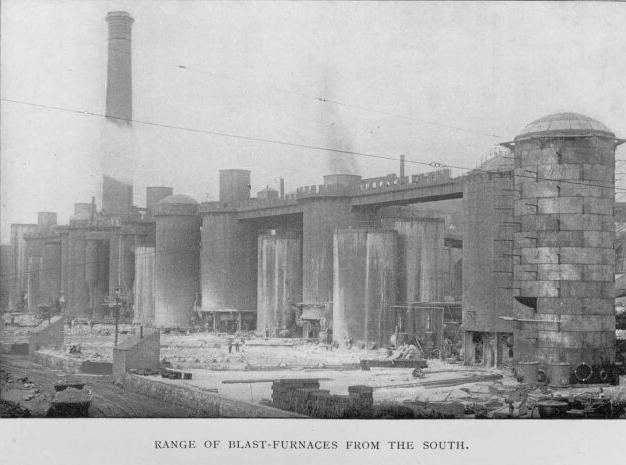Hide
DESCRIPTION
hide
Hide
of the
CONSETT IRON WORKS
Part 2
EARLY HISTORY.
IN the decade between 1830-40, the applicability of iron to innumerable purposes connected with the railway system gave an impetus to the iron trade; and it having been discovered that the local coal measures contained bands of ironstone, the establishment of Iron Works at Consett was decided on.
In 1840, a Company was formed under the title of the Derwent Iron Company, the late Mr. Jonathan Richardson being the principal promoter. Most of the ironstone in the district was leased, as were also several large royalties of coal. Blast-furnaces were erected, and rolling mills laid down, the ironstone for the former being obtained from shafts sunk in the immediate neighbourhood, the first being denominated Number One, by which name the locality is still known. After a time, however, it was found that the local ironstone was becoming scarce, and expensive to work, and eventually Cleveland had to be resorted to for supplies. The Company gradually extended their operations until they possessed eighteen blast-furnaces, seven of these being at Consett, while seven more had been erected at Crookhall, and four at Bradley, both these places being a little to the north-east of the main Works. In addition to the blast-furnaces, the Company had in operation at this time rolling mills, collieries, coke ovens, &c., and a large population had already settled in the neighbourhood. In 1857, the stoppage of the Northumberland and Durham District Bank brought about a crisis in the affairs of the Company. It soon became known that they owed the Bank nearly a million pounds, and endeavours were immediately made to protect the Company's property for the benefit of the creditors. Subsequently the Works were disposed of to a number of shareholders of the Bank, who formed themselves into a Company, whose registered title was the. Derwent and Consett Iron Company, Limited. But changes were not yet ended. The Company found themselves unable to complete the purchase as they had projected, and in the course of two years the property was again put up for sale, and was purchased by the present Consett Iron Company, Limited. The date of the formation of the Company was April, 1864. Amongst the property purchased were the Works at Consett, Crookhall, and Bradley, consisting of eighteen blast-furnaces, with puddling forges, extensive plate, angle and bar mills, and other adjuncts, producing 80,000 tons of pig iron per annum, and from 40,000 to 50,000 tons of finished iron. Five hundred acres of freehold land, attached to the Works, and more than a thousand freehold cottages, with manager's house and offices, were included in the purchase, which also embraced the transference of coal royalties well adapted for iron making. The capital of the Company was £400,000, divided into 40,000 shares of £10 each. The original directors were Messrs. H. Fenwick, M.P., Chester-le-Street; John Henderson, M.P., Leazes House, Durham; J. E. Coleman, Tokenhouse Yard, London; J. W. Pease, Darlington; J. Fogg Elliott, Durham; Thomas Spencer, The Grove, Ryton; J. Norman Wilson, Sunderland; J. Priestman, Shotley Bridge; and David Dale, Darlington. Mr. Priestman was appointed Managing Director, which position he resigned in 1869. The only one of the above gentlemen still remaining a director is Mr. Dale, the present Chairman, whose connection with the concern dates back to the year 1857, having thus made up the long period of 36 years. He was appointed Managing Director in October, 1869, and in 1884, on the death of Mr. John Henderson, the then Chairman, he was appointed Chairman. In this way Mr. Dale's knowledge of the business and of the property of the Company is considerable, and it gives precision and promptitude at the directors' conferences and Board meetings.
At the time of the formation of the present Company only six out of the eighteen blast-furnaces which they acquired were in blast, and there were at Consett ninety-nine puddling furnaces, besides thirty-one puddling furnaces at Bishopwearmouth Iron Works, which latter had been amalgamated with the Derwent Iron Company at an early stage of their career. To the north of the main Works were Tin Plate Mills, owned by Richardson & Co., and two years after the formation of the present Company they also acquired this property, by which they added to their plant twenty-seven puddling furnaces and three plate mills, together with a colliery which was much nearer the Works than their own pits. The ironworks at Bishopwearmouth were soon dismantled and the operations concentrated at Consett, and the manufacture of tin plates was discontinued, and the Works utilized for the production of iron plates, although the name of the Tin Mill still clings to it, and is that by which this portion of the Works continues to be known.

COAL AND COKE.
Collieries. - The coal field possessed or held in lease by the Company extends over an area of 13,000 acres. At the present time they have in operation ten collieries, namely, Westwood, Medomsley, Derwent, Hunter, Eden, Blackhill, and Delves (all in the neighbourhood of Consett), two at Langley Park, near Durham, and one at Garesfield, from which latter coal is largely shipped on the Tyne. The usual annual output at these collieries has exceeded a million tons, but when the measures now in progress for opening out a large tract of untouched coal on the north side of the Derwent have been carried out, the production will probably reach one-and-a-half millions. This mineral property being adjacent to the outcropping of the Durham coalfield, the seams lie generally at a moderate depth from the surface, and, happily, they are therefore free from the presence of inflammable gas, and, moreover, the mines are not seriously burdened with water. Although near the outcropping edge of the measures, as has been said, yet in part of the Company's holding nearly the whole of the workable coal seams in the Durham field, with their various qualities, are met with, those of most extensive prevalence being the Busty and Brockwell Seams, so well known for their high-class coking character; and from these seams the major part of the output of the Company's collieries is at present being raised.
Coke.-The number of coke ovens in operation is about 1,050, and the annual production of coke therefrom about 500,000 tons. The larger proportion of this is consumed at the Company's blast-furnaces, and the remainder is disposed of for use in the furnaces, &c., of Cumberland, Cleveland, and foreign pig iron producing centres.
BLAST-FURNACES.
When the transfer of the old plant to the new Company took place, there were six blast-furnaces at Consett, and also one which had been pulled down, and the foundations of which were being prepared for the erection of a larger furnace. The furnaces were all open topped as shown in the accompanying view.

The blast was heated by cast iron U and pistol pipe stoves, fired by coal, and having a blast pressure of 31/4 lbs. to the square inch. There were four beam blowing engines, namely, a single blast engine, steam, cylinder 2-ft. 81/2-in. diameter, blast cylinder 6-ft. 0-in. diameter, with 6-ft, 0-in. stroke; a double-blast engine, steam cylinders each 2-ft. 11-in. diameter, blast cylinder each 6-ft. 7-in. diameter, with 7-ft. 8-in. stroke; and a single blast and rolling mill engine, steam cylinder 3-ft: 8-in. diameter, blast cylinder 7-ft. 0-in. diameter, with 6-ft. 11-in. stroke. At Crookhall, there were three beam blowing engines-a single blast engine, steam cylinder 2-ft: 8-in. diameter, blast cylinder 6-ft 81/2-in. diameter, with 8-ft. 0-in. stroke; and a double blast engine, steam cylinders each 3-ft. 2-in. diameter, blast cylinders each 8-ft. 0-in. diameter, with 8-ft. 6-in, stroke. A double blast engine was also in use at Bradley, steam cylinders each 3-ft. 1-in. diameter, blast cylinders each 7-ft. 6-in. diameter, with 7-ft. 11-in stroke. The blast-furnaces at Crookhall and Bradley were blown out, and the blast engines at Consett have since then been either thrown altogether out of use, or thoroughly reconstructed. At the present time there are four large beam blowing engines, made by the Lilleshall Iron Company, each with- a steam cylinder 4-ft. 2-in. diameter, blast cylinders each 8-ft. 4-in. diameter, with 9-ft. 0-in stroke. There are also two beam blowing engines, made by Murray, of Chester-le-Street, and thoroughly reconstructed, steam cylinders each 2-ft. 11-in. diameter, blast cylinders each 6-ft. 7-in. diameter, with 8-ft. 0-in. stroke; besides two beam blowing engines, made by Abbot, of Gateshead, and Clarke, of Sunderland, steam cylinders each 3-ft. 1-in. diameter, blast cylinders each 7-ft. 6-in. diameter, with 7-ft. 11-in. stroke.
In 1865 one large blast-furnace, with five tuyeres, was in blast, and produced about 340 tons per week, while the smaller ones produced about 230 tons per week each. These small furnaces were not adapted to the modern requirements of the trade, and the growing demand for iron, therefore, rendered the reconstruction of the blast-furnace plant necessary Accordingly, within the next eight years, the whole of the furnaces originally erected at Consett were pulled down and six larger ones substituted. In the year 188o, a seventh furnace, similar to the others, was added, thus completing the present range.
Blast furnaces.-These seven blast-furnaces are each 55-ft. high, and 9-ft. diameter of hearth; height to top of boshes, 2o-ft.; diameter of top of boshes, 20-ft.; diameter of throat, 14-ft. 6-in.; and bell with 10-ft. 6-in. opening. There are seven tuyeres to each furnace. All the furnaces are fed with material by means of bell and hopper, with standard beam and hydraulic brake, with an escape gas tube and slide at the top 1-ft. 8-in. diameter, regulated by means of a chain and pulley worked by the stoveman at the bottom of the furnace.
Each of the furnaces is provided with a dustcatcher, which delivers the dust direct into wagons or iron barrows. All the furnaces are connected by means of a gangway at the top, and the charging material is run in iron barrows to the foot of an incline 125-ft. long, and having a total rise of 15-ft., up which incline eight full barrows are hauled at a time on a large, cage while a similar number of empty ones- are descending to be filled. The ore and other material for the furnaces is brought in on a high-level approach, considerably above the tops of the blast-furnaces, and is there tipped into gears through bottom board trucks on to a level with the foot of the incline above mentioned, and where the barrows are filled.

Stoves.-Four of the blast-furnaces have four of Whitwell's hot blast fire-brick stoves to each furnace, all of them 22-ft. diameter. One furnace has two stoves 65-ft. high, another stove is 45-ft. high, and a fourth is 40-ft. high. A second furnace has four stoves, each of which is 46-ft. high. Another furnace has one stove 65-ft. high, two 40-ft high, and one 35-ft. high. The other furnace has two stoves 45-ft. high, and two 40-ft. high. The other three furnaces have three Cowper stoves to each furnace. Two of them have stoves 21-ft. diameter by 65-ft. high, while the other has stoves 24-ft. diameter by 66-ft. high. The pressure of blast now maintained is 41/2-lbs. per square inch, and its temperature on entering the furnace, ascertained by Siemens copper ball pyrometer and latest scale, is about 1300° Fah. At the present time five furnaces are in blast. The other two are being re-lined. All the five furnaces are making Bessemer pig, and produce on an average 750 tons per furnace per week, from a mixture mainly composed of Bilbao-Rubio ore, with .a small admixture of other pure ores. The largest week's make of a single furnace is 919 tons of Bessemer pig iron, of which 85 per cent was No.1 quality, the remainder being Nos. 2 and 3. The limestone used comes from Stanhope in Weardale, and the coke from the Consett Company's own collieries. Since the substitution, to a very large extent, of the manufacture of steel plates instead of those of iron, the use of ironstone from the Cleveland district has been discontinued.

Originally the Company obtained their supply of hematite ore from Cumberland and Lancashire, but in the year 1872 they amalgamated with the Dowlais Iron Company, Herr Krupp of Essen, and Messrs. Ybarra of Spain, in the formation of the Orconera Iron Ore Company, Limited. This Company having acquired large hematite mines at Bilbao in Spain, they proceeded to develop them by the construction of railways, shipping staithes; &c., at a cost of £500,000 and for a considerable number of years the Consett Company have received, and still receive, therefrom large supplies of hematite ore of excellent quality.
Boilers.-The steam required for driving the blast engines is raised by thirteen double egg-ended boilers, each consisting of two lengths 35-ft. long by 4-ft. 6-in. diameter, six long egg-ended boilers each 70-ft. long by 4-ft. 6-in. diameter, and twelve double tubular boilers, each 31-ft. 4-in. long, six of which are 7-ft. diameter, and the remainder 7-ft. 6-in. diameter. The waste gas is taken from the top of the furnaces through the dustcatcher and downcomer (at the foot of which a wing valve is provided for the purpose of disconnecting any particular furnace while it is off blast or during a temporary stoppage) into a large underground brick flue 10-ft. high by 6-ft. wide, from which it is distributed for the purpose of heating the stoves and boilers, the waste gases from which pass through a larger sized underground brick flue to a large fire-brick chimney, 250-ft. high from the surface of the ground, and 16-ft. 6-in. diameter inside at the top. The erection of this chimney, which is a landmark for the surrounding country, was begun on the 28th of May, 1868, and without a single day's stoppage was finally completed on the 3rd of October in the same year. The principal quantity of water used at the Consett blast-furnaces and boilers is obtained from the Consett Waterworks Company, and after passing through the tuyeres is pumped up again by large 1-ft. diameter double-ram pumps from a low level hot water pond to a high level cooling reservoir, from which it flows in pipes to the tuyeres and to the casting beds for the purpose of cooling the pigs, the pressure being about 20 lbs. to the square inch.
The slag from the furnaces is run into conical circular moulds, placed on iron bogies, which when full are hauled by means of locomotives (similar to those which haul away the bogies of pig iron) in trains to the tip end, which is about 100-ft. high, and upwards of half-a-mile from the furnaces. The balls of slag, each weighing from three to four tons, are then stripped of their conical covers, and tipped over the end of the heap.
Electric Machinery.-In each of the two blast engine houses there is placed a large horizontal double cylinder steam engine, each steam cylinder having a diameter of 1-ft. 51/2-in. by 2-ft. 4-in. stroke, with a fly wheel 10-ft. diameter, over which a belt runs on to a sheave 3-ft. 2-in. diameter. The axle on which this sheave is fixed has also five other wrought iron sheaves, each 4-ft. 6-in. diameter, keyed on to it, each of which drives, by means of a hair belt running over a small sheave 1-ft. 2-in. diameter, a Brush dynamo, capable of driving twenty-five double carbon electric arc lamps, each 2,000 nominal candle power, which lights are distributed over the various departments of the Works. Another dynamo is being fixed for the purpose of driving, by electric motors, three pumps in. the Blackhill Colliery Drift, and which are capable of pumping from 158 to 240 gallons of water per minute.
OCR by Ken Postle, Ottawa, Canada
August 2001.
